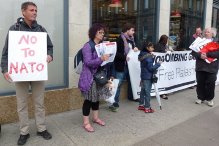Eric Chester (RCN) reports on the official opening of the UK government’s First World War commemoration in Glasgow on August 4th.

The UK government is determined to use the commemoration of World War I as an opportunity to promote militarism and imperialism and to defend the British role during that war. The last part of the ceremony on August 4 at George Square made this blatantly clear, as soldiers and sailors strutted around the square in military fashion to the applause of many in the audience. Jingoism in its purest form. (August 4, 2014 marks one hundred years since the UK entered World War I. An observance was held at Glasgow Cathedral followed by a wreath laying ceremony at George Square in the heart of the city centre.)
Substantial resources are being devoted to this project. The elaborate ceremonies on August 4 were only the starting point for a four year program of patriotic propaganda. Bringing Prince Charles, Cameron, Clegg and Miliband to Glasgow, they were joined by Salmond, are indications of the priority being placed on the government’s campaign to celebrate the ‘Great War.’
When the Scottish Peace Network decided to organise a counter-protest, we understood that this would be met with significant resistance. Nevertheless, our demonstration was a success, with about fifty people participating. (The flurry of demonstrations protesting the assault on Gaza may have held down this number.) We handed out thousands of flyers, waved our placards and banners within sight of the ‘dignitaries,’ and upheld our right to dissent even at times and places when the authorities seek to project a spurious sense of national unity.
Throughout the ceremonies there was a heavy police presence, and the cops ranged from cool to unfriendly. In general, the police strategy sought to avoid a direct confrontation, and arrests, while confining us to authorized protest zones some distance from the ceremonies and the ‘important people’. Protesters who went to the cathedral were kept in a protest zone some distance from the entrance, although along the route taken by some of the limousines that carried dignitaries from there to George Square. The Peace Camp members who unfurled the large ‘No Glory in War’ banner at the top of the Necropolis were threatened with arrest after only ten minutes at that location.
In George Square, police snipers were placed on roof tops and cops with machine guns were placed a few feet from the group of protesters that I joined. The square was divided by a complex set of high fences, preventing anyone except the favoured few from getting close to the wreath laying ceremony. A police officer tried to pressure us into sending the entire group to one protest zone on the north side of George Square. We ignored his directives and wound up with signs and banners along both sides of the square.
Of course, going along the police strategy of isolation and containment was the lack of coverage by the mass media. There can be no doubt that reporters covering the ceremony at George Square saw our signs and banners, but there was zero coverage. A BBC reporter came to our protest group on the south side of the square, but he did not interview anyone or take any pictures and again there was no coverage. Our demonstration presented a position outside of the mainstream discourse and thus, in true Orwellian terms, it did not exist.
Finally, there were the loyalists waving their union jacks and cheering on the soldiers. A few were interested in getting into a fight with the protesters. When members of the White Feather Collective unfurled a protest banner inside of the central area reserved to those who had obtained tickets, they were threatened with physical assault by loyalists. One participant in the protest group I joined at George Square was called “scum” by a loyalist who was eager to get into a tussle.
Throughout the first part of the ceremony in George Square our protest group had cops along side of us. They were then withdrawn, so the only cop I saw when loyalists began acting in a threatening manner was on the other side of the fence. Had a fight broken out, he would have been of no help.
This was a different experience than that in Stirling on June 28, where we countered Armed Forces Day. Then, the police posted unarmed officers near us as deterrents to those ‘patriots’ looking for a fight. On August 4, the implicit message from the police was that we were on our own if we ignored their rules and regulations. Clearly we can not rely on the police, who seem to be willing to tolerate the hooliganism of the loyalists. We will need to develop a coherent and thoughtful response to this problem.
In spite of all the obstacles, the demonstration on August 4 was a success. The Scottish Peace Network has worked harmoniously through two difficult demonstrations over a period of several months. We need to build on our success in organising the demonstrations on June 28 and August 4 by planning more protests and developing a series of educational forums that present an alternative to the government’s policy of militarism and imperialism.
The Scottish Peace Network has brought together a wide range of peace and social justice organisations into an ongoing coalition. We began with a commitment to opposing the government’s use of the commemoration of World War I as a platform from which to promote militaristic policies. We have expanded our efforts to calling for an end to Scotland’s, and the UK’s, participation in NATO and opposition to the UK’s support for U.S. imperial adventures in the Middle East and elsewhere. The SPN has begun to create the basis for a viable peace movement in Scotland.
also see
Emancipation & Liberation Special Bulletin – The Centenary of the World War I Imperialist Slaughter
